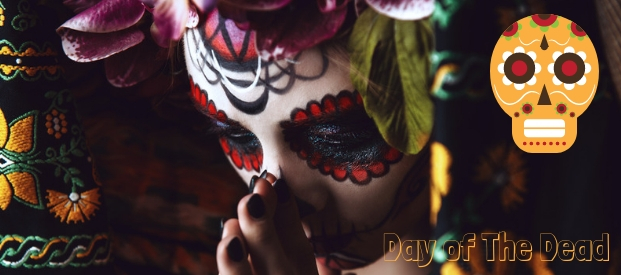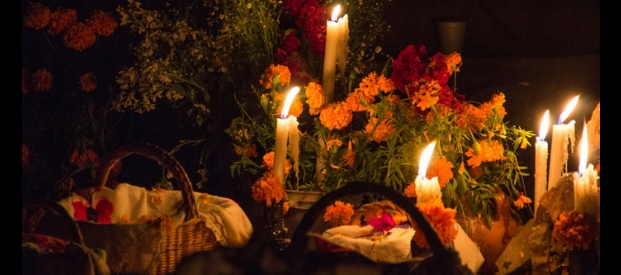Day of the Dead – Dia de los Muertos
Bright orange flowers decorating every grave in the cemetery, sugar skulls in shop windows, parades, costumed crowds with painted skull faces – the colourful celebrations for Mexico’s Day of the Dead or Día de los Muertos are an increasingly familiar sight, thanks to the media and some recent major films. Less understood are its centuries-old significance and the symbolic meanings behind the rituals.
The Aztec people did not believe in mourning the dead. They believed that even after death, people carried on being part of the community and therefore death was part of a joyous progression, to be celebrated with prayers for the continuing spiritual journey. For the Aztecs there were several layers of the afterlife: thirteen layers of heavens above us and nine layers of the underworld below. Those who died the most honourable deaths such as warriors in battle, women in childbirth or those who died in sacrifice attained the highest level of afterlife. The Aztecs celebrated the dead with a whole month of rituals and festivities in the ninth month of the Aztec year.
When the Spanish arrived in the sixteenth century, bringing the Catholic faith to Mexico, they failed to stamp out the traditional celebrations and instead they moved the festival to 1st & 2nd November to coincide with All Saints’ Day and All Souls’ Day. The Day of the Dead became a mixture of ancient tradition and Catholic beliefs.
The first of the two days is known as Día de los Angelitos or Day of the Little Angels, and on this day people remember children who have died. The second day, 2nd November, is the real Día de los Muertos when the adult dead temporarily return from the afterlife to visit friends and family.
Age-old traditions
Throughout Mexico, families create an altar for the Day of the Dead, decorating it with flowers, candles, family photographs and paper decorations and adding offerings to encourage dead relatives or friends to visit. The offerings might include an ancestor’s favourite meal and a drink to refresh them after the long journey from the other world, traditionally pulque (a drink made from agave sap), atole (made from corn flour, sugar, cinnamon and vanilla) or hot chocolate. Often there will be Pan de Muerto, sweet bread of the dead, studded with anise seeds and decorated with bones and skulls made of dough and arranged in a circle as in the circle of life, and with tiny dough teardrops to symbolise sorrow. There might be cigarettes, beer, toys for a child, or sugar skulls, colourfully decorated and often bearing the names of the dead.
In the cemeteries, relatives clean the graves and adorn them with bright orange marigolds and decorations cut from coloured papers. These are common at all times in Mexico, but are especially popular on altars and graves where they flutter in the breeze, representing the wind and the fragility of life. Vigils are held through the night, but these are not sombre occasions. There will be music, tequila, picnics held at gravesides, and meetings with friends and neighbours. Most importantly there will be stories shared about the dead, with anecdotes about funny occasions and happy times. Today, Pátzcuaro in Michoacan state is particularly known for lively graveside vigils and many people, both locals and tourists, take boats to Isla de Janitzio, to honour the dead in the island’s cemeteries. Between the altar and the grave, pathways lined with marigolds help the ancestors find their way back to the grave at the end of the day.
Poems, skulls and skeletons
Over time, newer traditions have been assimilated into the Day of the Dead. Witty poems, known as Calavera (meaning ‘skulls’) first appeared in newspapers in the late 18th century. These clever ‘epitaphs’ poke fun at the living and are still part of the Día de los Muertos celebrations today. Political cartoonist, José Guadalupe Posada took this a stage further, satirising death through a series of etchings showing clothed skeletons performing everyday activities. He mocked the wealthy by portraying death as a skull in a large, fancy feminine hat. Artist Diego Rivera included this character in a mural in the 1940s, making the skeleton female and calling her La Catrina.
Today the Calavera Catrina has become an iconic symbol of the Day of the Dead. During the festival life-size skeleton statues, clothed and decorated, take their places around towns and cities; figurines are sold in shops; and people dressed as Catrinas with painted skull faces, parade the streets.
In the 21st century
In this century UNESCO recognised Día de los Muertos as a living expression of tradition passed down through the generations and, in 2008, added it to their list of Intangible Cultural Heritage of Humanity.
In the film world, the opening sequence of the 2015 James Bond movie Spectre brought Mexico City’s spectacular Day of the Dead Parade onto screens worldwide. One year earlier, the animated film, Book of Life, explored the fantastical Land of the Remembered, stunningly created by of its Mexican director and animator from their imaginations and childhood memories. Disney and Pixar’s film Coco, released in 2017, also depicted a breathtakingly fabulous world of the dead with decorated cemeteries, altars and other images associated with today’s festivities.
It’s hardly surprising that in recent years the Day of the Dead celebrations have extended to Spain, Brazil and other South American countries, and spread over the border from Mexico into the United States and across the globe.











